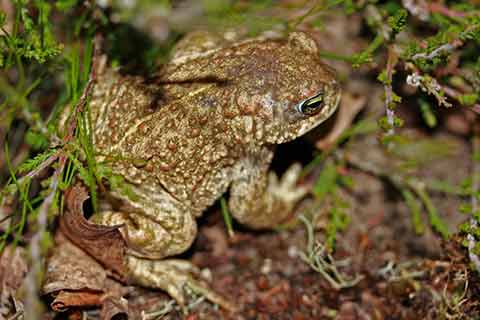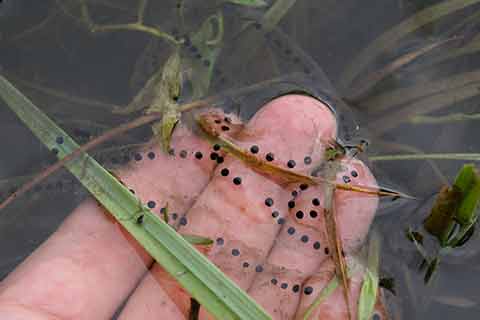What's the difference between frogs and toads?
Our amphibian friends may look similar, but there are a few key differences you can look out for to tell them apart.
Common frogs
- Have smooth, moist skin, which isn't slimy
- Have special glands to keep the skin moist and supple - this helps them to 'breathe' through their skin as well as their lungs, so they can stay underwater for a long time
- Are mottled shades of green, yellow or brown in colour
- Have a distinct brown patch behind the eye
- Move in springy leaps and lay spawn in clumps.
Common toads
- Have dry, warty skin, which means they can't 'breathe' through their skin as well as frogs, but they can survive on land in drier places
- Are usually grey-brown in colour
- Crawl rather than hop
- Lay strings of eggs in long, double rows.
Natterjack toads
- Have a yellow stripe down their back
- Are speedy - they often run quite fast!
- Lay strings of eggs in long, single rows.


Helping frogs and toads in spring
If you have a pond in your garden, you may find large amounts of frogspawn at this time of year. It can make the water look overcrowded, but it's nothing to worry about.
Toads and their annual migration
Each spring, toads may be seen migrating in large groups and can travel over a kilometre to return to their pond to breed. At this time, toads are vulnerable when crossing roads, with many being squashed by cars.
You can help by carefully carrying the toads across the road; many areas organise toad patrols. For more advice on how to help toads during their migration, take a look online at the Toads on Roads project.
Frogs and toads: a gardener's friend?
Both frogs and toads eat a lot of beetles, bugs and woodlice. Frogs will eat a large number of slugs and snails, whereas toads favour ants.
Don't be surprised if you find frogs or toads in your greenhouse. They're attracted there by the warm, moist conditions and will live in a greenhouse quite happily, eating the insects and other small creatures that live there.
Find out more about Britain's amphibians and how you can help them.
What to do if you find a sick or injured frog or toad
If you find a sick or injured frog or toad, visit the Froglife website for guidance about how to help them. It can be difficult to treat amphibians, so sometimes it’s best to leave them in the garden to recover on their own.
If the animal is seriously sick or injured, then the quickest way to get them help will be to contact a vet.
You should be able to confine frogs and toads without having to touch them directly - this will help reduce their stress.
Here's what to do step by step:
- Approach the animal slowly and quietly, and place a box on top of them, then carefully slide the box lid or a piece of cardboard underneath so you can pick the box up.
- Make sure the box has holes for ventilation, and line it with damp paper towels to keep their skin moist.
- Don’t use newspaper to line the box, as the chemicals from the ink could harm them.
- Keep the box somewhere that's not too hot and away from pets, and take them to a vet or rehabilitator for treatment as soon as possible.
Only handle amphibians if you can't avoid it. Always wear disposable gloves and rinse the gloves with water before you pick up the animal.
Don’t touch them with bare hands as they are very sensitive to chemicals on our skin.
If you see sick, injured or dead amphibians in your garden, please report these to Garden Wildlife Health, which helps monitor diseases in garden wildlife.




